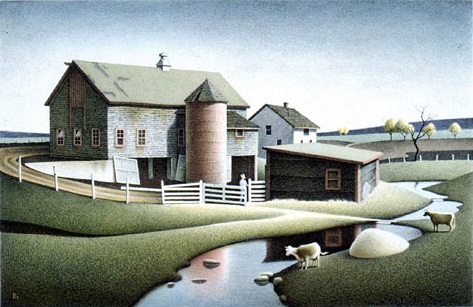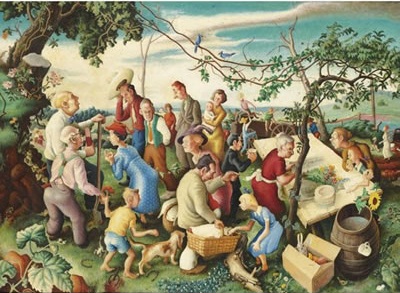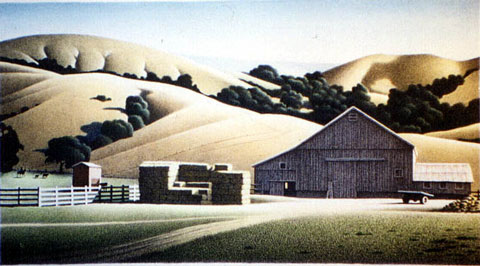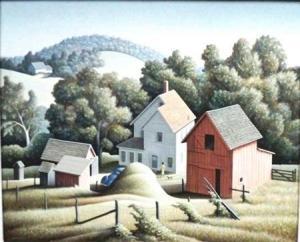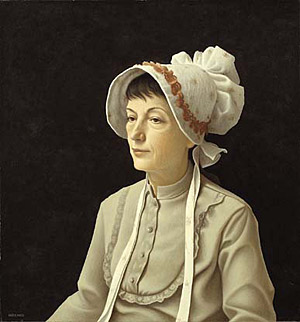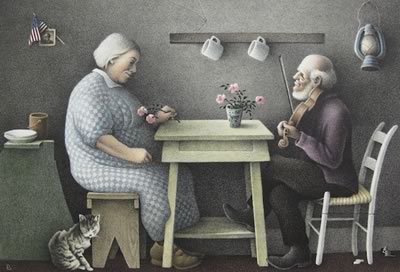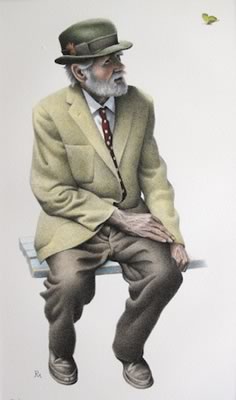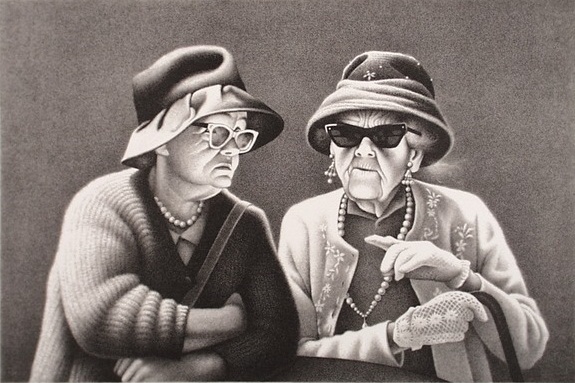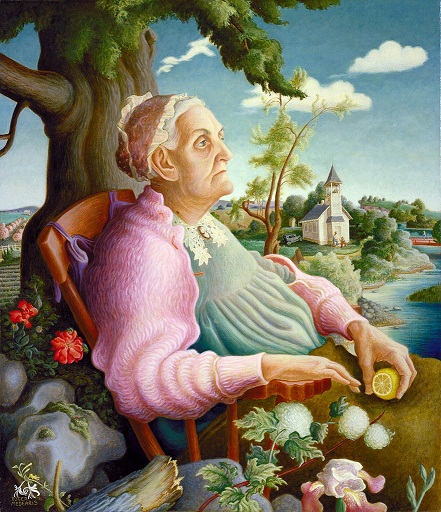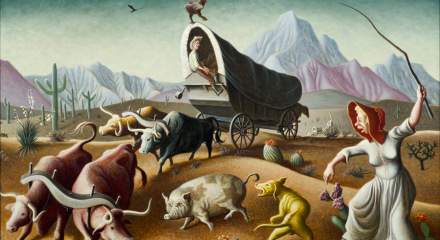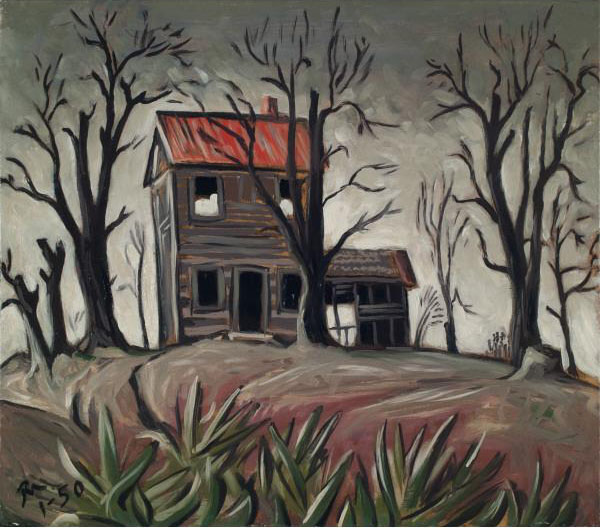<Back to Index>
- Painter John Rogers Cox, 1915
- Painter Roger Medearis, 1920
PAGE SPONSOR
Cox was born in Terre Haute, Indiana in 1915. His father, Wilson Naylor Cox, was president of the Terre Haute National Bank, later Terre Haute First National Bank. John Rogers was one of four brothers, Wilson Naylor "W.N." Cox, Jr., the eldest, born in 1909, Francis "Fritz" Gardenhire Cox, the next oldest born two years later, and twins John Rogers and Benjamin Guille born on March 24, 1915. Cox's parents sent him to the University of Pennsylvania to study business but he later enrolled in a Bachelor of Fine Arts program conducted jointly by the University of Pennsylvania and the Pennsylvania Academy of the Fine Arts. He graduated in 1938. After failing to find a commercial arts job in New York he returned to Terre Haute and found work as a bank messenger and later a teller. He married Mary Hermine Mayer, a Terre Haute local, on December 27, 1939, and they eventually had three children, two sons, John Rogers Cox, Jr. and Henry Douglas Cox and a daughter, Janet Naylor Cox, born in 1943 who died in childhood.
Cox left his job at the bank in 1941 and was appointed the first director of the newly formed Sheldon Swope Art Museum in Terre Haute having been offered the position by William T. Turman, professor of art at Indiana State Teachers College, a recognized artist and chief adviser to the Swope. Cox, describing Turman's job offer, said
- "When I heard the word 'painting' and when he offered me $600 a year more than I was making, it didn't take me more than a minute to say yes!"
At 26, he was the youngest museum director in the U.S. Cox assembled the Swope's founding collection purchasing 23 paintings by living American artists in the 15 months before the inaugural show which contained new works by artists such as Grant Wood, Thomas Hart Benton, Charles Burchfield, Zoltan Sepeshy and Edward Hopper. The museum opened to the public on March 21, 1942. The founding collection is still the feature for which the museum is best known.
Cox left the museum and enlisted in the US Army in 1943. He left the army in 1945 and decided to dedicate his time to painting. By 1948, Cox had completed nine paintings, sold seven, and won two important prizes. Life magazine included a double page color feature about Cox in its July 12, 1948 edition. The article included his painting Wheat and a self portrait. Cox moved to Chicago in 1948 after the death of his daughter and the break-up of his marriage the previous year. He remained in Chicago, teaching at the School of the Art Institute of Chicago until 1965 where he specialized in figure drawing. After 1950 he focused on producing pen and pencil drawings rather than oil paintings.
Cox eventually remarried in 1963 to Donise Kibby, a student of his at the Art Institute of Chicago. They moved several times from Chicago, to Galena, to New Orleans where they had one daughter, Sophia, in 1966. They then moved to Washington, finally settling in Wenatchee in the 1970s. They divorced in the mid 1980s, although they stayed in touch until John's move to Louisville, Kentucky, where he died on January 30, 1990 at the age of 74.
Cox's output as an artist was relatively modest but his works featured in numerous important annual living artist exhibitions during the 1940s and '50s. He worked slowly, painting his landscapes at home, from memory, often taking a year or two to finish a painting. His paintings number fewer than 20.
One of Cox's best known works is Gray and Gold from 1942, held in the permanent collection Cleveland Museum of Art. The painting was produced shortly after the United States joined the Second World War. It was Cox's second oil painting. The Cleveland Museum of Art bought the painting from a traveling exhibition, 'Artists for Victory', consisting of works by artists who wanted to help in the war effort. The exhibition opened at the Metropolitan Museum of Art (The Met) in New York on December 7, 1942, the first anniversary of attack on Pearl Harbor and Cox's painting was awarded the Second Medal. The work also received the Popular Prize in the Carnegie Institute of Pittsburgh's annual 'Painting in the United States' 1944 exhibition of paintings by living artists.
Cox's painting White Cloud was exhibited at the 1944, Painting in the United States Carnegie survey show and won a 300 US dollar prize. Life magazine covered the exhibition and noted "Some critics believe that his stark landscapes will make him as famous as the late Grant Wood". Cox painted White Cloud in 1943, adding further details in 1946. The work was acquired by the Swope Art Museum in 2000. The painting depicts a dry and desolate landscape, with two trees and a barren field. An abandoned plow sits in the foreground and a large house can be seen in the distance. Brian Lee Whisenhunt, the Swope's director, noted "Despite the weathered and desolate scene, hope remains: a white cloud, voluptuous and full of promised rain, floats above the dry and parched landscape connoting a potentially better future." The painting was included in the Smithsonian American Art Museum's To Make a World: George Ault and 1940s America exhibition in 2011.
Cox's 1944 painting, Cloud Trails, consists of a landscape of precisely painted wheat stalks devoid of human figures under an expanse of blue sky with cloud trails and a full moon near the horizon. A barn in the landscape is covered with brightly colored advertisements typical of the artist's Midwestern hometown. The painting was purchased by the Saint Louis Art Museum in 2006 who describe it as one of Cox's "unsettling American Scene landscapes".
Cox's 1949 painting, Wheat Fields, uses a highly saturated palette of pinks, blues and oranges to portray what the Norton Museum of Art described as "a Midwestern version of a garden of plenty with an endlessly extended crop field". The painting was purchased by the Norton Museum in 2008.
Cox only produced one lithograph,
Wheat Shocks (1951). A signed print produced from
the lithograph is held in the Cleveland Museum of Art's
collection.
Work by Cox was included in the Indianapolis Museum of Art's 63rd Annual Exhibition of Contemporary American Paintings, in 1951. The Sheldon Swope Gallery held a John Rogers Cox retrospective exhibition in 1982 on its 40th anniversary. The museum currently holds five works by Cox, including a self portrait drawn in pencil and his portrait of William T. Turman.
The art historian, John I.H. Baur, described Cox's work as an exemplar of "hard, immaculate - related realism" in his 1951 study Revolution and Tradition in Modern American Art for the Library of Congress. Michael D. Hall, describing Cox's work in an essay to accompany the Flint Institute of Arts's exhibition in 2003, Great Lakes Muse: American Scene Painting from the Upper Midwest, 1910 - 1960, said "His own signature landscape vistas are imaginary Midwestern places filled with emptiness - visual contradictions suffused with momentous and ominous signs."
Cox claimed to know nothing about painting in an interview for Life magazine in July, 1948. He said that he intended to continue painting because he enjoyed it, adding "I'm too dumb to do anything else". Cox regarded the effect of painting as somewhat mysterious.
Good painting offers a mysterious pleasure that one cannot quite put his finger on because the painter, through honesty and hard work, has actually painted his own personality in a familiar subject; and any person’s personality or character or soul, or whatever your word is for it, is something of an enigma.—John Rogers Cox, 1951
Cox was interviewed about his work by the American Artist magazine in October 1951. He said the following about his working method.
I hardly ever paint a picture the same way twice. Sometime I make sketches before starting, sometimes I draw directly on the canvas or panel and then paint, and sometimes I just begin to paint directly. Other times I make detailed sketches of parts of my idea in oil on little panels and pieces of cardboard … Hours are consumed rearranging these oil sketches in various compositions to find what shape of picture I want.—John Rogers Cox, 1951
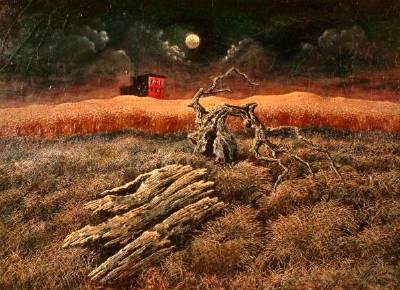
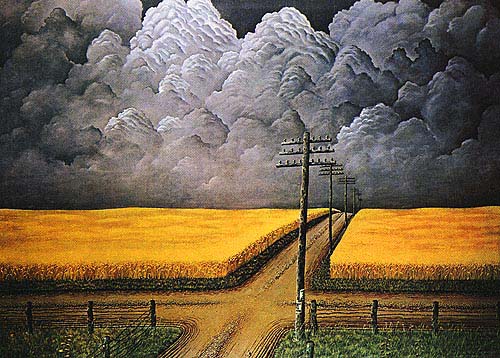
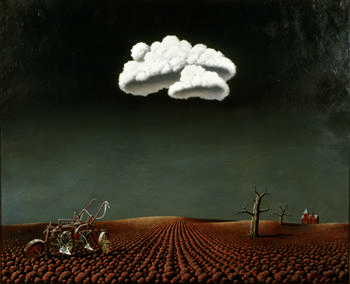
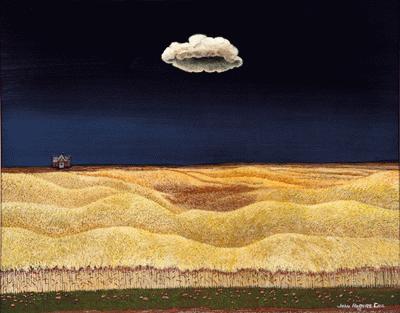
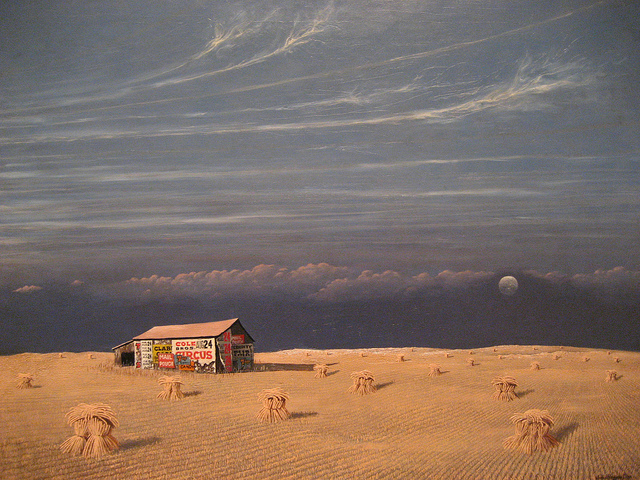
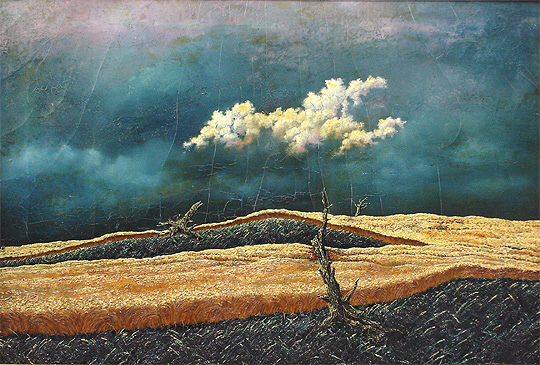
Roger Medearis (March 6, 1920 - July 5, 2001) was an American Regionalist painter. He was a student of Thomas Hart Benton while at the Kansas City Art Institute in the late 1930s and took up the technique of egg tempera painting, a rediscovered medium popular with Regionalists. Benton introduced Medearis to the Associated American Artists Gallery in New York City, from which he sold a portrait of his grandmother, Godly Susan, now in the collection of the Smithsonian Museum of American Art.
After World War II, Regionalist art fell out of fashion, replaced by Abstract Expressionism. Unable to sell his works, Medearis stopped painting. In 1966, Philip Desind, a Maryland art dealer, discovered Medearis' work and encouraged him to return to painting. Medearis painted new works until his death in 2001.
Medearis' paintings and lithographs can be found in the collections of the Butler Institute of American Art, the Kemper Museum of Contemporary Art, the Nelson-Atkins Museum of Art, and the Smithsonian Museum of American Art. He also has a painting hanging next to one of Thomas Hart Benton at the Huntington Library in San Marino, CA. His later years were spent in San Marino with his wife and children.
